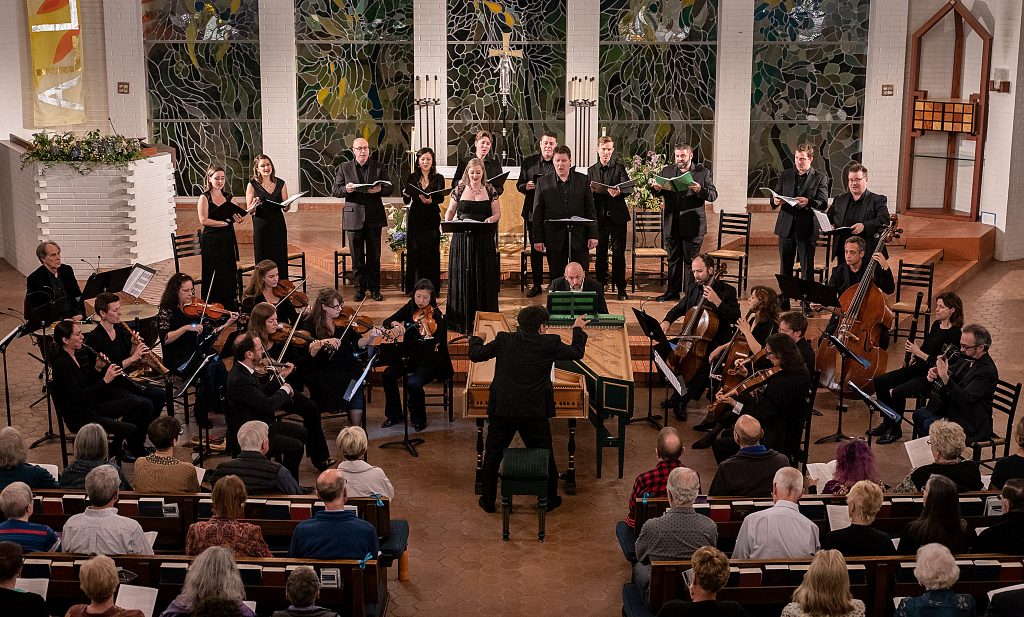Bach Collegium San Diego Reveals of the Musical Glories of Purcell’s ‘King Arthur’
Real opera has always been a tough sell in England’s vaunted cultural milieu. Poor George Frederick Handel lavished a dozen splendid Italian operas on the London public in his first decade of British residence, and then the fickle Londoners jilted Handel and his opera company—driving it into bankruptcy—for the musical trifle of John Gay’s The Beggar’s Opera, arguably the first musical comedy.

The Bach Collegium San Diego in “King Arthur” [photo (c.) Gary Payne]
Without the slightest cavil, King Arthur is a brilliant score, replete with some of Purcell’s most infectious, elegantly structured instrumental movements—variously called overture, prelude, chaconne or passacaglia—which the 19 period instruments under the astute direction of BCSD Artistic Director Ruben Valenzuela performed with vigor, stylistic insight, and admirable ensemble. Similarly, Valenzuela’s 12-member chorus produced a fresh, vibrant sonority that energized King Arthur’s significant choral components down to the shortest refrain with refreshing clarity and zeal.

Clara Rottsolk & Sumner Thompson [Photo (c.) Gary Payne]
Thompson thrilled us in his commanding Act 5 aria with full orchestra, “Ye blustring brethren of the skies,” as did as his hearty, sonorous declamation as Cold Genius in Act 3, “Great Love, I know thee now.” Of the several inspired duets between these two singers, I would herald “Sound a parley, ye fair, and surrender” in Act 3 a gem of florid, Italianate lines gracefully interwoven, one of the composer’s most felicitous duets. Tenor Jason McStoots proved persuasive as the inebriated Comus in Act 5, leading with avid humor and his bright vocal line the other 5 tenors and basses of the chorus, who responded in virile, tipsy antiphony. His lilting aria in Act 2 “Bright nymphs of Britain” ended with the astute couplet:
Let not youth fly away without contenting; age will come time enough for your repenting.
Librettist John Dryden no doubt ruffled the moralists of his day.
Fleet natural trumpet players Kathryn Adduci and Melissa Rogers added sonic gold to the full orchestra ensemble, and Purcell used them liberally. In Act 5, he wrote an elaborate Trumpet Tune that put First Trumpet Adduci in clever dialogue with Concertmaster Adam LaMotte–so rewarding to compare to that “Purcell” Trumpet Tune in D Major played ubiquitously at weddings that is in truth a rather simple ditty by his younger colleague Jeremiah Clarke.
As usual, Valenzuela’s skilled continuo ensemble provided smartly turned out bass support throughout, led by Associate Music Director Michael Sponseller at the harpsichord. Ruben Valenzuela provided miraculous double duty both conducting and adding the second contiuno harpsichord.
As satisfying as this musical experience of King Arthur was, the dramatic rewards of its presentation lagged far behind. King Arthur, Merlin, and their Saxon counterparts were completely absent because none of the spoken parts of this semi-opera were performed. Although terse program notes and a well-attended pre-concert lecture provided a precis of the actual drama around which this music revolves, the work’s dramatic progression was missing in action. Imagine attending Carmen in concert without the presence of either Carmen or Don José.
So David Bennett of San Diego Opera or Peter Kozma of Opera NEO–how about presenting the entire semi-opera of King Arthur in the Balboa Theatre in an upcoming season?
This performance was presented by the Bach Collegium San Diego on Friday, May 3, 2019, at All Souls’ Episcopal Church in Point Loma and was repeated on May 4, 2019, at the Greek Orthodox Church of Sts. Helen and Constantine in Cardiff, CA.

Ken Herman, a classically trained pianist and organist, has covered music for the San Diego Union, the Los Angeles Times’ San Diego Edition, and for sandiego.com. He has won numerous awards, including first place for Live Performance and Opera Reviews in the 2017, the 2018, and the 2019 Excellence in Journalism Awards competition held by the San Diego Press Club. A Chicago native, he came to San Diego to pursue a graduate degree and stayed.Read more…

Fantastic King Arthur! Never heard anything like it! I think I smiled the whole time, from astonished delight….
In the country and century of Shakespeare, with more excellent playwrights than you can shake a stick at, the Londoners liked plays – thousands of them in the 17th Century – with one or two songs in the comedies and a bit of instrumental music. That is not a limited aesthetic, it is a taste.
In particular, the genre of play-songs known as Mad Songs, of which Purcell wrote some of the most emotionally moving, with other composers also writing showstoppers (John Eccles in particular) are truly extraodinary. Try ‘From Silent shades’ and Eccles ‘I burn, I burn’ – best sung by Catherine Bott. Yiu will never forget them.